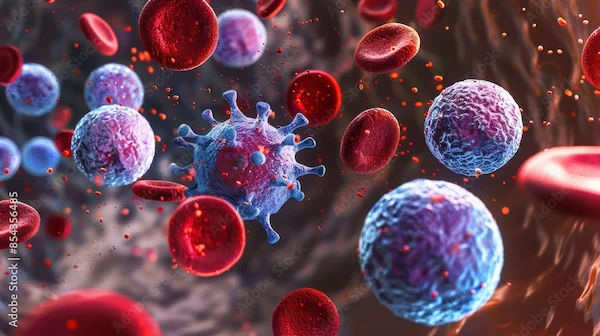Multiple Myeloma Recognising the Signs and Understanding Your Treatment Options
Know about the multiple myeloma, what it is, causes, symptoms, treatment options, diagnosis and living well with multiple myeloma.

Written by Dr. Md Yusuf Shareef
Reviewed by Dr. D Bhanu Prakash MBBS, AFIH, Advanced certificate in critical care medicine, Fellowship in critical care medicine
Last updated on 7th Oct, 2025

Introduction
Multiple myeloma might sound like a complex and intimidating diagnosis, but understanding its signs and the available treatment options is the first step toward taking control of your health. This cancer, which affects plasma cells in your bone marrow, can manifest through a variety of symptoms that are often mistaken for normal signs of ageing or other common conditions. This comprehensive guide is designed to demystify multiple myeloma for patients and their loved ones. Whether you're seeking information for yourself or a family member, our goal is to provide clear, actionable knowledge that empowers you to have informed conversations with your healthcare team.
What is Multiple Myeloma? A Basic Overview
At its core, multiple myeloma is a cancer that forms in a type of white blood cell called a plasma cell. Healthy plasma cells are essential to your immune system; they produce antibodies that help you fight infections. In multiple myeloma, these cells become cancerous and multiply uncontrollably, crowding out healthy blood cells in the bone marrow. Instead of producing helpful antibodies, they release abnormal proteins (M proteins) that can cause complications throughout the body. These cancerous cells also gather in the bone marrow, forming tumours that can weaken and damage bones, leading to pain and fractures. It's important to distinguish multiple myeloma from related conditions like MGUS (Monoclonal Gammopathy of Undetermined Significance), which is a benign precursor that may or may not progress to myeloma. Understanding this fundamental mechanism helps make sense of the symptoms and the goals of various multiple myeloma treatment options.
Consult a Top Oncologist for Personalised Advice
Early Warning Signs: Listening to Your Body
The early symptoms of multiple myeloma can be vague and easily overlooked. Many people live with smouldering myeloma (an early, asymptomatic stage) for years without any issues. However, when the disease becomes active, it typically presents a set of symptoms that doctors categorise.
The CRAB Criteria: When Myeloma Becomes Active
The acronym "CRAB" is used by haematologists to identify the key features of active, symptomatic multiple myeloma that require treatment.
C - Calcium (Elevated)
As myeloma cells break down bone, high levels of calcium are released into the bloodstream. This can cause extreme thirst, nausea, stomach pain, confusion, and constipation.
R - Renal (Kidney) Failure
The abnormal M proteins produced by myeloma cells can damage the kidneys, impairing their ability to filter waste. This may not have obvious symptoms initially, but it will show up in blood tests.
A - Anaemia
The overgrowth of cancerous plasma cells in the bone marrow crowds out red blood cell-producing cells. This leads to anaemia, causing persistent fatigue, weakness, dizziness, and shortness of breath.
B - Bone Lesions
Myeloma cells stimulate the breakdown of bone, creating painful lytic lesions that appear as holes on X-rays. This often causes severe, persistent bone pain, most commonly in the back, ribs, or hips, and increases the risk of fractures.
Other Common Symptoms to Note
Beyond the CRAB criteria, patients may experience frequent infections due to a weakened immune system, numbness or weakness in the legs from spinal cord compression, unexplained weight loss, and general confusion. If you experience a combination of these symptoms, especially persistent bone pain or fatigue that doesn't improve with rest, it is crucial to seek medical evaluation. If symptoms persist beyond two weeks, consult a doctor online with Apollo24|7 for further evaluation.
Getting a Diagnosis: The Steps to Confirmation
Diagnosing multiple myeloma involves a series of tests to confirm the presence of cancerous plasma cells and assess the extent of the disease. If your doctor suspects myeloma based on your symptoms, they will typically start with blood and urine tests to look for the M protein and check kidney function and blood cell counts. A bone marrow biopsy, where a small sample of bone marrow is extracted (usually from the hip), is the definitive test to confirm the diagnosis. Imaging tests like X-rays, CT scans, MRIs, or PET scans are used to check for bone lesions and determine the stage of the cancer. This comprehensive diagnostic workup is critical for creating a personalised treatment plan.
Mapping Your Journey: Multiple Myeloma Treatment Options
The landscape of multiple myeloma care has transformed dramatically over the past two decades. Today, treatment options are highly personalised, based on factors like the stage of the disease, the patient's age and overall health, and specific genetic markers within the cancer cells.
The First Line of Defense: Initial Treatment for Newly Diagnosed Myeloma
For those who are eligible, the initial phase of treatment is often the most aggressive, aiming to achieve deep remission.
Combination Drug Therapy: The Backbone of Treatment
Modern initial treatment rarely relies on a single drug. Instead, doctors use a combination of different classes of medications that attack the cancer cells in various ways. Common combinations include:
* Proteasome Inhibitors (e.g., Bortezomib): Work by disrupting the cancer cells' protein disposal system, causing them to die.
* Immunomodulatory Drugs (e.g., Lenalidomide): Help the immune system recognise and attack myeloma cells and also cut off the blood supply to tumours.
* Monoclonal Antibodies (e.g., Daratumumab): Target specific proteins on the surface of myeloma cells, marking them for destruction by the immune system.
* Steroids (e.g., Dexamethasone): Are used to enhance the effectiveness of the other drugs and reduce inflammation.
Stem Cell Transplantation: A Chance for Deeper Remission
For eligible patients (typically younger and healthier), a stem cell transplant follows initial drug therapy. High-dose chemotherapy is used to destroy the bone marrow, and then previously collected healthy stem cells are infused back into the patient to rebuild the immune system. This is an intensive procedure, butit can lead to longer periods of remission.
Managing the Disease: Treatment for Relapsed or Refractory Myeloma
Multiple myeloma is often characterised by periods of remission and relapse. When the cancer returns (relapses) or doesn't respond to initial treatment (refractory), doctors have a wide arsenal of new treatments for multiple myeloma. These may include different drug combinations, newer classes of drugs like histone deacetylase inhibitors or antibody-drug conjugates, or a second stem cell transplant. The choice depends on what treatments the patient has had before and how long the remission lasted.
Supportive Care: Treating the Symptoms and Side Effects
This is a critical component of comprehensive care. Supportive therapies don't treat the cancer directly but manage its complications and the side effects of treatment. This includes:
1. Bisphosphonates: Drugs to strengthen bones and reduce pain.
2. Blood transfusions or growth factors: To manage anaemia.
3. Pain medication: To control bone pain.
4. Plasmapheresis: A procedure to remove excess M protein from the blood if it's causing thick blood.
Apollo24|7 offers convenient home collection for tests like vitamin D or HbA1c, which can be important for monitoring overall health during treatment.
The Role of Clinical Trials in Advancing Myeloma Care
Clinical trials are research studies that test new treatments or new combinations of existing treatments. For many patients, especially those with relapsed or refractory disease, participating in a clinical trial can provide access to cutting-edge therapies that are not yet widely available. The significant progress in multiple myeloma survival rates is directly attributable to patients who have participated in clinical trials.
Living Well with Multiple Myeloma: Diet, Exercise, and Mental Health
A diagnosis of multiple myeloma is a life-changing event, and managing overall well-being is crucial. A balanced diet rich in protein and nutrients can help maintain strength during treatment. Gentle exercises like walking or yoga can combat fatigue, strengthen bones, and improve mood. Equally important is addressing mental health; seeking support from counsellors, support groups, or family can help manage the anxiety and stress that accompany a cancer journey.
Conclusion
Understanding the signs of multiple myeloma and the available treatment options empowers you to be an active participant in your healthcare journey. While a myeloma diagnosis is serious, the outlook has never been brighter, with a continuously expanding arsenal of effective therapies helping patients live longer, fuller lives. The path involves careful monitoring, personalised treatment plans, and a strong focus on quality of life. If you have concerns about any symptoms, the most important step is to consult a healthcare professional for a proper evaluation. If your condition does not improve after trying these methods, book a physical visit to a doctor with Apollo24|7.
Consult a Top Oncologist for Personalised Advice
Consult a Top Oncologist for Personalised Advice

Dr Sunita Samleti
Oncologist
18 Years • M.D. (Pathology)- TN Medical College, Mumbai University, Mumbai, Mar 2005 M.B.B.S. Grant Medical College, Mumbai University, Mumbai, Oct 1999
Chinagadila
Apollo Hospitals Health City Unit, Chinagadila

Dr. Sanchayan Mandal
Medical Oncologist
17 Years • MBBS, DNB Raditherapy, DrNB Medical Oncology
East Midnapore
VIVEKANANDA SEBA SADAN, East Midnapore

Dr Gowshikk Rajkumar
Oncologist
10 Years • MBBS, DMRT, DNB in Radiation oncology
Bengaluru
Apollo Clinic, JP nagar, Bengaluru

Dr.sanchayan Mandal
Medical Oncologist
17 Years • MBBS, DrNB( MEDICAL ONCOLOGY), DNB (RADIOTHERAPY),ECMO. PDCR. ASCO
Kolkata
Dr. Sanchayan Mandal Oncology Clinic, Kolkata

Dr. Gopal Kumar
Head, Neck and Thyroid Cancer Surgeon
15 Years • MBBS, MS , FARHNS ( Seoul, South Korea ), FGOLF ( MSKCC, New York )
Delhi
Apollo Hospitals Indraprastha, Delhi
(25+ Patients)
Consult a Top Oncologist for Personalised Advice

Dr Sunita Samleti
Oncologist
18 Years • M.D. (Pathology)- TN Medical College, Mumbai University, Mumbai, Mar 2005 M.B.B.S. Grant Medical College, Mumbai University, Mumbai, Oct 1999
Chinagadila
Apollo Hospitals Health City Unit, Chinagadila

Dr. Sanchayan Mandal
Medical Oncologist
17 Years • MBBS, DNB Raditherapy, DrNB Medical Oncology
East Midnapore
VIVEKANANDA SEBA SADAN, East Midnapore

Dr Gowshikk Rajkumar
Oncologist
10 Years • MBBS, DMRT, DNB in Radiation oncology
Bengaluru
Apollo Clinic, JP nagar, Bengaluru

Dr.sanchayan Mandal
Medical Oncologist
17 Years • MBBS, DrNB( MEDICAL ONCOLOGY), DNB (RADIOTHERAPY),ECMO. PDCR. ASCO
Kolkata
Dr. Sanchayan Mandal Oncology Clinic, Kolkata

Dr. Gopal Kumar
Head, Neck and Thyroid Cancer Surgeon
15 Years • MBBS, MS , FARHNS ( Seoul, South Korea ), FGOLF ( MSKCC, New York )
Delhi
Apollo Hospitals Indraprastha, Delhi
(25+ Patients)
More articles from Multiple Myeloma
Frequently Asked Questions
1. Is multiple myeloma curable?
While multiple myeloma is currently considered a treatable but generally incurable cancer, many patients achieve long-term remissions where the cancer is undetectable. With new treatments for multiple myeloma, patients are living for a decade or more after diagnosis, with a good quality of life.
2. What is the difference between MGUS and multiple myeloma?
MGUS (Monoclonal Gammopathy of Undetermined Significance) is a benign condition where abnormal M protein is present but at low levels, with no other signs of cancer, like bone damage or high cell counts. It requires monitoring but not treatment. Multiple myeloma is an active cancerous disease that MGUS can sometimes progress to.
3. What are the common side effects of multiple myeloma treatment?
Side effects vary by drug but can include fatigue, nausea, nerve damage (peripheral neuropathy), lowered blood counts (increasing infection risk), and an increased risk of blood clots. Your doctor will provide medications and strategies to manage these side effects.
4. How is life expectancy with multiple myeloma determined?
Life expectancy varies greatly and depends on the cancer's stage, genetic abnormalities, the patient's overall health, and how well the cancer responds to treatment. The International Staging System (ISS) and genetic risk factors are key tools doctors use for prognosis.
5. Can diet and exercise really help with multiple myeloma?
Yes. A nutritious diet helps maintain strength and support the immune system during treatment. Regular, gentle exercise can reduce treatment-related fatigue, improve mood, and help maintain bone density. Always discuss any new diet or exercise regimen with your oncology team.
